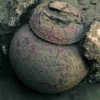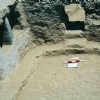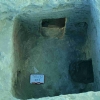The areas used by the people of Tuspa as a graveyard were the region in north of the Van citadel. Especially the northern areas of the Tuşpa necropolis have a limestone texture which can sometimes be observed at the surface. For this reason, it is especially suitable for burial chambers to be opened underground..
A total of 35 rock grave were uncovered during the excavations carried out at the Altintepe Necropolis. Grave rooms vary in itselt with dimensions, room numbers, direction insights and internal arrangements. The grave rooms are descended from the surface by a square or rectangular dromos. The main burial ares can be reached from dromos, mostly arched, vertically opened doors, which are covered with flag stones placed vertically. In some examples, the dromos connect two separate rooms. In some examples, small cavities were opened on the walls of the dromos and the descent into the grave was facilitated. The ground floor of the burial chambers is lower. In addition to examples that large-chambered and side walls is with niche and was carved to main rock, smaller multi-room samples are also available. In addition to square rectangular samples with rounded edges, there are also oval, rounded and shapeless examples. This type of graves has a very rough workmanship. The side walls are generally not flat, the ceiling is formed with round transitions. The ceiling is usually flat and in some examples it is arched. On the walls of the burial chambers, niches are usually opened. Small niches are likely to be left of burial gifts. The the larger ones is likely to have been used as a dead bed, burial site.
The graves were dated to the Middle Iron Age based on the finds uncovered. It is understood that the burial concept in burial chambers was applied as multiple burials as in other chamber graves. In addition to normal burials, cremation burials were also applied in the same area. In additon to ornament items such as iron swords and wedges, bronze arcs, ornamental needles, earrings and rings, bead necklaces and so on, potteries in which probably dead food and drink are put are among the main grave finds.
Urnes were placed in the openings into the soil or main rock in Altıntepe. The mouth of the urnes was again covered with a bowl. The grave gifts placed in or around the Urnes do not show any difference with the grave gifts we have seen in other Urartian grave types. Ornamental needles, iron knives and wedges, bronze bracelet earrings and rings and bead necklaces are the most common gifts. Some examples include swords, bronze belts and bronze vessels.









